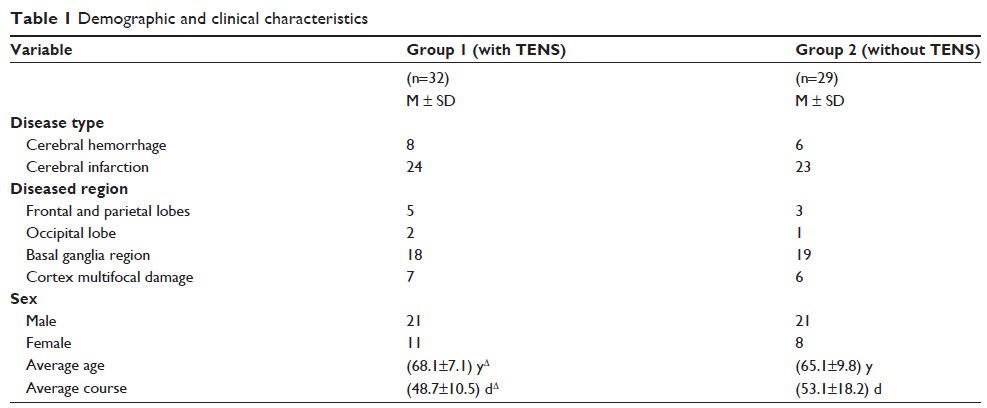108605
论文已发表
注册即可获取德孚的最新动态
IF 收录期刊
- 3.4 Breast Cancer (Dove Med Press)
- 3.2 Clin Epidemiol
- 2.6 Cancer Manag Res
- 2.9 Infect Drug Resist
- 3.7 Clin Interv Aging
- 5.1 Drug Des Dev Ther
- 3.1 Int J Chronic Obstr
- 6.6 Int J Nanomed
- 2.6 Int J Women's Health
- 2.9 Neuropsych Dis Treat
- 2.8 OncoTargets Ther
- 2.0 Patient Prefer Adher
- 2.2 Ther Clin Risk Manag
- 2.5 J Pain Res
- 3.0 Diabet Metab Synd Ob
- 3.2 Psychol Res Behav Ma
- 3.4 Nat Sci Sleep
- 1.8 Pharmgenomics Pers Med
- 2.0 Risk Manag Healthc Policy
- 4.1 J Inflamm Res
- 2.0 Int J Gen Med
- 3.4 J Hepatocell Carcinoma
- 3.0 J Asthma Allergy
- 2.2 Clin Cosmet Investig Dermatol
- 2.4 J Multidiscip Healthc

已发表论文
经皮神经电刺激治疗卒中后尿失禁患者
Authors Guo ZF, Liu Y, Hu GH, Liu H, Xu YF
Published Date May 2014 Volume 2014:9 Pages 851—856
DOI http://dx.doi.org/10.2147/CIA.S61084
Received 21 January 2014, Accepted 2 April 2014, Published 23 May 2014
Purpose: To investigate the therapeutic effect of transcutaneous electrical nerve stimulation (TENS) on poststroke urinary incontinence (UI).
Patients and methods: Sixty-one patients with poststroke UI were enrolled at the Neurology Department in the Shanghai Tenth People’s Hospital of Tongji University between January 2010–January 2011 and were divided into treatment and control groups (n=32 and n=29, respectively). TENS was applied to the treatment group, while the control group received basic therapy. The therapeutic group completed the whole set of TENS therapy with a treatment frequency of 30 minutes once a day for 60 days. The positive electrode was placed on the second lumbar spinous process, and the negative electrodes were inside the middle and lower third of the junction between the posterior superior iliac spine and ischia node. The overactive bladder symptom score, Barthel Index, and urodynamics examination were estimated before and after therapy in both groups.
Results: The daily micturition, nocturia, urgent urination, and urge UI in the treatment group significantly improved compared to the control group (P <0.05). The patients in the treatment group were superior in the self-care ability of daily living and also had an advantage over the indexes on maximum cystometry volume, flow rate, and the pressure of detrusor in the end of the filling phase.
Conclusion: TENS improved incontinence symptoms, enhanced the quality of life, and decreased adverse effects; hence, it is recommended in treating poststroke UI.
Keywords: stroke, urinary incontinence, OABSS, Barthel Index, urodynamics, transcutaneous electrical nerve stimulation
Patients and methods: Sixty-one patients with poststroke UI were enrolled at the Neurology Department in the Shanghai Tenth People’s Hospital of Tongji University between January 2010–January 2011 and were divided into treatment and control groups (n=32 and n=29, respectively). TENS was applied to the treatment group, while the control group received basic therapy. The therapeutic group completed the whole set of TENS therapy with a treatment frequency of 30 minutes once a day for 60 days. The positive electrode was placed on the second lumbar spinous process, and the negative electrodes were inside the middle and lower third of the junction between the posterior superior iliac spine and ischia node. The overactive bladder symptom score, Barthel Index, and urodynamics examination were estimated before and after therapy in both groups.
Results: The daily micturition, nocturia, urgent urination, and urge UI in the treatment group significantly improved compared to the control group (P <0.05). The patients in the treatment group were superior in the self-care ability of daily living and also had an advantage over the indexes on maximum cystometry volume, flow rate, and the pressure of detrusor in the end of the filling phase.
Conclusion: TENS improved incontinence symptoms, enhanced the quality of life, and decreased adverse effects; hence, it is recommended in treating poststroke UI.
Keywords: stroke, urinary incontinence, OABSS, Barthel Index, urodynamics, transcutaneous electrical nerve stimulation
